View in other NatureServe Network Field Guides
NatureServe
Montana
Utah
Wyoming
Idaho
Wisconsin
British Columbia
South Carolina
Yukon
California
New York
Matted Prickly-phlox - Leptodactylon caespitosum
Other Names:
Linanthus caespitosus, Linanthus cespitosus
State Rank Reason (see State Rank above)
This plant occurs in Montana at the edge of a broad but patchy range. It is known from only a dozen or so mostly small populations, all in the Pryor Mountains - Bighorn Canyon area, and is confined to a highly specific substrate. The habitat of this plant receives little human disturbance and there are no evident threats.
- Details on Status Ranking and Review
Population Size
Score2 - Small: Generally 2,000-10,000 individuals.
Range Extent
Score3 - Local Endemic or Very Small Montana Range: Generally restricted to an area <10,000 sq. miles (equivalent to the combined area of Phillips and Valley Counties) or <6 Sub-basins (4th code watersheds) Range-wide OR limited to one Sub-basin in Montana
Area of Occupancy
Score2 - Low: Generally occurring in 4-10 Subwatersheds (6th Code HUC’s).
Environmental Specificity
Score1-2 - Moderate to High.
CommentPrimarily confined to Chugwater Sandstone.
Trends
ScoreNA - Rank factor not assessed.
Threats
Score0-1 - Low to Medium.
CommentNo specific threats have been identified.
Intrinsic Vulnerability
Score0-1 - Low to Moderate Vulnerability.
CommentDoes not appear to be especially vulnerable as a result of any biological factors.
Raw Conservation Status Score
Score
8 to 11 total points scored out of a possible 16 (Rarity factors and threats only).
General Description
PLANTS: A taprooted, cushion-forming perennial with a highly branched root crown that gives rise to numerous ascending to erect stems, 2-6 cm high. Plants form dense mats, 10-60 cm across. Source: Lesica et al. 2012.
LEAVES: Stems have closely spaced internodes which are obscured by the opposite leaves and axillary fascicles. Most leaves are deeply palmately divided into 2-3 equally-lobed segments (ternate), rigid, and spine-tipped (mucronate). The foliage is nearly glabrous to sparsely glandular and ciliate. Sources: McGregor et al. 1986; Lesica et al. 2012.
INFLORESCENCE: Solitary flowers are borne at the stem tips. The calyx is united with 4 sparsely hairy uneven lobes, 4-7 mm long. The white (or sometimes cream, salmon, or pink-colored) corolla has a tube, 10-15 mm long, and 4 spreading lobes, each 3-5 mm long. Four anthers are borne near the top of the tube. The fruit is a round capsule. Source: Lesica et al. 2012.
“Leptodactylon” means thin fingers, referring to the narrow leaf segments.
Phenology
Flowering occurs in May-June, and capsules ripen in June.
Diagnostic Characteristics
In the Phlox Family (Polemoniaceae), some low-growing
Phlox can resemble
Lepotdactylon caespitosum:
Leptodactylon*Subshrubs that are mat-forming or openly branched.
*Leaves are deeply divided and either alternate or opposite on the stem.
*Flowers are either 4- or 5-merous.
Phlox*Herbaceous, but many species form dense to loose mats.
*Leaves are simple and alternate on the stem.
*Flowers are 5-merous.
*Possible look-alikes:
Phlox bryoides,
Phlox hoodii, and other low-growing
Phlox.
Matted Prickly-phlox -
Lepodactylon caespitosum, SOC, native
*Subshrubs with dense, ascending branches that form mats or cushions (caespitose).
*Leaves are deeply divided and opposite on the stem.
*Flowers are 4-merous.
*Plants are known to occur on Chugwater sandstone.
Granite Prickly-phlox -
Leptodactylon pungens, native
*Subshrubs with open, ascending branching.
*Leaves are deeply divided and alternate on the stem.
*Flowers are 5-merous.
Species Range
Montana Range
Range Descriptions
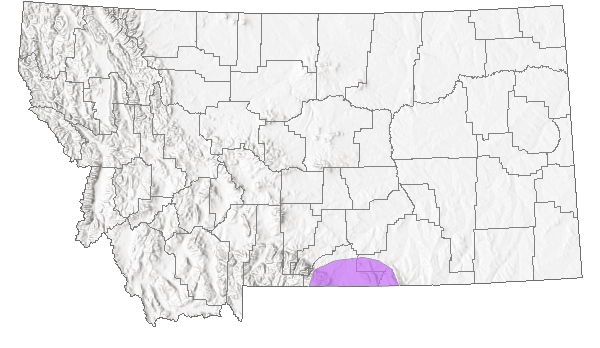
 Native
Native
Range Comments
In Montana, Matted Prickly-phlox is only known from the Pryor Mountains in Carbon County. This species also ranges south to Wyoming, Nevada, and east to Nebraska (Lesica et al. 2012; NatureServe Explorer). More than half of the populations surveyed in 1992 had fewer than 100 plants. In Utah, Matted Prickly-phlox has a disjunct distribution due to its preference for particular soil types (Welsh et al. 1987).
An observation from Big Horn County was made prior to the development of a mine. A survey of intact habitat in vicinity of the mine could validate the presence or absence of the plant and its habitat.
Observations in Montana Natural Heritage Program Database
Number of Observations: 149
(Click on the following maps and charts to see full sized version)
Map Help and Descriptions
Relative Density
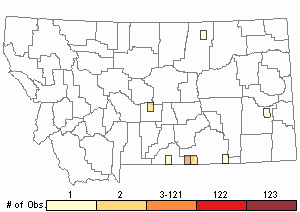
Recency
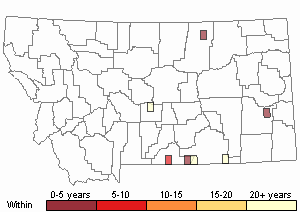

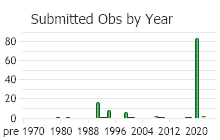
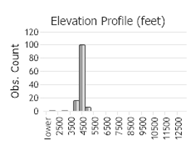 (Observations spanning multiple months or years are excluded from time charts)
(Observations spanning multiple months or years are excluded from time charts)
Habitat
Matted Prickly-phlox grows in sparsely vegetated steppe and juniper woodlands in the valley zones of Montana (Lesica et al. 2012). Specifically, this species is restricted to the foothills of the Pryor Mountains (below 5000 ft). It is typically found on north- or east-facing slopes in dry, open sandy breaks confined to barren eroding outcrops of Chugwater sandstone, an unusual though locally common substrate (Lesica and Achuff 1992). The Chugwater Formation consists mainly of siltstones and shales with interspersed sandstones. The formation is brick-red in color, caused by the oxidation of iron minerals in the rock (Cavaroc and Flores 1991). In Montana, the Chugwater sandstone is interbedded with gypsum. Elsewhere, it also appears to be confined to calcareous soils (Cronquist et al. 1984; Welsh et al. 1993).
National Vegetation Classification System Groups Associated with this Species
Forest and Woodland
Low Elevation - Xeric Forest and Woodland
Montane - Subalpine Forest and Woodland
Sparse and Barren
Sparse and Barren
Ecology
ASSOCIATED SPECIES
Matted Prickly-phlox can be found growing in woodlands dominated by Utah Juniper (Juniperus osteosperma) with occasional Limber Pine (Pinus flexilis)(Lesica and Achuff 1992). Small to sometimes large populations occur in communities often dominated by Rubber Rabbitbrush (Ericamaria nauseosa) and Moss Phlox (Phlox muscoides). Other common associates include Bluebunch Wheatgrass (Elymus spicatus), Blue Gramma (Bouteloua gracilis), Needle and Thread (Stipa comata), Hood’s Phlox (Phlox hoodii), Dwarf Mentzelia (Mentzelia pumila), Hooker’s Sandwort (Arenaria hookeri), Halogeton (Halogeton glomeratus), Tufted Milkvetch (Astragalus spathulatus), Rabbit Buckwheat (Eriogonum brevicaule var. canum), Rough Mule’s Ears (Wyethia scabra), Summer Milkvetch (Astragalus hyalinus), and Wooly Cryptantha (Cryptantha cana).
Reproductive Characteristics
Most species in the Phlox Family (Polemoniaceae) feature a "mixed" breeding system (both inbreeding and outbreeding systems) (Plitmann and Levin 1989). However, the genus Leptodactylon was found to be predominately xenogamous (outbreeding) based on a study which evaluated pollen to ovule ratios in 160 species within the Phlox family (Plitmann and Levin 1989).
FLOWERS
The calyx tube is 4-7 mm long, sparsely hairy with 4 uneven lobes. The white (or sometimes cream, salmon, or pink-colored) corolla tube is 10-15 mm long opening into 4 spreading lobes that are 3-5 mm long. Four anthers are borne near the top of the tube. The ovary is 2-chambered.
FRUITS
Fruit is a round, 2-chambered capsule that each contains several seeds (Lesica et al. 2012).
Management
RESEARCH NATURAL AREAS and AREA OF CRITICAL ENVIRONMENTAL CONCERN PROGRAM
The Research Natural Area (RNA) program is a nationwide system created to protect a network of federally administered public lands established for the purpose of scientific research, maintaining biological diversity, and education (USFS 2014). The intent is to designate RNAs that represent the full array of North American ecosystems with their biological communities, habitats, natural phenomena, and geological and hydrological formations. These intact protected areas are managed to maintain their natural and primitive character with a minimum of human disturbance. Each RNA also serves as a baseline of ecological information that can be used to compare against other similar, yet managed ecological systems.
A type of RNA is the Area of Critical Environment Concern (ACEC). The ACEC program was established in the 1976 Federal Lands Policy and Management Act and is managed by the Bureau of Land Management (BLM) (Wikipedia Contributors 2020). Places designated as ACECs require special management to protect important historical, cultural, and scenic values, fish and wildlife, or other natural resources (BLM 2021). The BLM has extended the purpose of RNAs to that of preserving gene pools of typical and endangered plants and animals (BLM 2015; BLM 2021).
Pryor Foothill RNA/ACEC
This RNA-ACEC was established in the Approved Resource Management Plan by the MT/Dakotas BLM, Billings Field Office, recommended for approval by the MT/Dakotas BLM State Director in 2015, and is awaiting final approval by the U.S Congress (BLM 2015). The RNA-ACEC is approximately 2,606 acres in size. The management goals for the Pryor Foothills RNA/ACEC are to protect a large concentration of BLM's special status plant species and rare plant communities (unique vegetation) and to protect significant historic and cultural values in the Gyp Springs area. Intact populations of Matted Prickly-phlox live within the Pryor Foothill RNA-ACEC. A scattering of populations occur in other parts of the foothills around the Pryor Mountains. See Range Comments.
POPULATION SIZE
Populations are often small, less than 100 plants, though large populations up to about 1,000 plants have been found at some sites.
GRAZING
Matted Prickly-phlox is considered to not be palatable to livestock (Montana Native Plant Society [MNPS] 2009) Given its low growth form, this plant is probably little impacted by livestock grazing. At one population, livestock had trailed through it with no evidence of plant mortality. There was no evidence of impacts to this species in two separate studies that focused on plant density differences between grazed and ungrazed areas (Fahnestock and Detling 1999; Milchunas and Noy-Meir 2004).
Stewardship Responsibility
Threats or Limiting Factors
In Montana, current and potential long-term threats to Matted Prickly-phlox include:
Gypsum Mining: Gypsum is a common mineral found in the Chugwater Formation. Potential negative impacts from mining activities include direct removal and trampling of plants. Potential indirect negative impacts from mining activities include disturbance to habitat from soil erosion, soil compaction, and colonization by invasive species. Soils in the Chugwater Formation are known to be very susceptible to erosion.
Invasive Species: The arid landscape in which Matted Prickly-phlox occurs is predominately in native, intact habitat. However, Cheatgrass (Bromus tectorum) and African mustard (Malcolmia africans) are known to occur along roads that are near to Matted Prickly-phlox populations. There is the potential for negative impacts based on the assumption that these exotics would be more competitive for soil water and nutrient resources. STATE THREAT SCORE REASON
Reported threats to Montana's population of Matted Prickly-phlox are due to multiple, likely interacting, negative impacts common to roadside habitats (MTNHP Threat Assessment 2021).
References
- Literature Cited AboveLegend:
 View Online Publication
View Online Publication BLM Billings Field Office. 2015. Approved Resource Management Plan Appendices. Billings, MT: U.S. Department of the Interior Bureau of Land Management. 438 p.
BLM Billings Field Office. 2015. Approved Resource Management Plan Appendices. Billings, MT: U.S. Department of the Interior Bureau of Land Management. 438 p. Cavaroc, V.V. and R.M. Flores. 1991. Red beds of the Triassic Chugwater Group, Southwestern Powder River Basin, Wyoming. pp. E1-!17. IN: V.F. Nuccio, P.L. Hansley, W.A. Cobban, and C.G. Whitney, Evolution of Sedimentary Basins: Powder River Basin. Denver, CO: U.S. Geological Survey Bulletin, 1917-E.
Cavaroc, V.V. and R.M. Flores. 1991. Red beds of the Triassic Chugwater Group, Southwestern Powder River Basin, Wyoming. pp. E1-!17. IN: V.F. Nuccio, P.L. Hansley, W.A. Cobban, and C.G. Whitney, Evolution of Sedimentary Basins: Powder River Basin. Denver, CO: U.S. Geological Survey Bulletin, 1917-E. Cronquist, A., A.H. Holmgren, N.H. Holmgren, J.L. Reveal, and P.K. Holmgren. 1984. Intermountain Flora: Vascular Plants of the Intermountain West, U.S.A. Vol. 4, Subclass Asteridae (except Asteraceae). Bronx, NY: New York Botanical Garden. 573 pp.
Cronquist, A., A.H. Holmgren, N.H. Holmgren, J.L. Reveal, and P.K. Holmgren. 1984. Intermountain Flora: Vascular Plants of the Intermountain West, U.S.A. Vol. 4, Subclass Asteridae (except Asteraceae). Bronx, NY: New York Botanical Garden. 573 pp. Fahnestock, J.T. and J.K. Detling. 1999. The influence of herbivory on plant cover and species composition in the Pryor Mountain Wild Horse Range, USA. Plant Ecology 144(2):145-157.
Fahnestock, J.T. and J.K. Detling. 1999. The influence of herbivory on plant cover and species composition in the Pryor Mountain Wild Horse Range, USA. Plant Ecology 144(2):145-157. Lesica, P. and P.L. Achuff. 1992. Distribution of vascular plant species of special concern and limited distribution in the Pryor Mountain desert, Carbon County, Montana. Unpublished report to the Bureau of Land Management. Montana Natural Heritage Program, Helena, MT. 105 pp.
Lesica, P. and P.L. Achuff. 1992. Distribution of vascular plant species of special concern and limited distribution in the Pryor Mountain desert, Carbon County, Montana. Unpublished report to the Bureau of Land Management. Montana Natural Heritage Program, Helena, MT. 105 pp. Lesica, P., M.T. Lavin, and P.F. Stickney. 2012. Manual of Montana Vascular Plants. Fort Worth, TX: BRIT Press. viii + 771 p.
Lesica, P., M.T. Lavin, and P.F. Stickney. 2012. Manual of Montana Vascular Plants. Fort Worth, TX: BRIT Press. viii + 771 p. McGregor, R.L. (coordinator), T.M. Barkley, R.E. Brooks, and E.K. Schofield (eds). 1986. Flora of the Great Plains: Great Plains Flora Association. Lawrence, KS: Univ. Press Kansas. 1392 pp.
McGregor, R.L. (coordinator), T.M. Barkley, R.E. Brooks, and E.K. Schofield (eds). 1986. Flora of the Great Plains: Great Plains Flora Association. Lawrence, KS: Univ. Press Kansas. 1392 pp. Milchunas, D.G. and I. Noy-Meir. 2004. Geologic grazing refuges and grassland diversity: A shortgrass steppe study. J. Range Management 57:141-147.
Milchunas, D.G. and I. Noy-Meir. 2004. Geologic grazing refuges and grassland diversity: A shortgrass steppe study. J. Range Management 57:141-147. MTNHP Threat Assessment. 2021. State Threat Score Assignment and Assessment of Reported Threats from 2006 to 2021 for State-listed Vascular Plants. Botany Program, Montana Natural Heritage Program, Helena, Montana.
MTNHP Threat Assessment. 2021. State Threat Score Assignment and Assessment of Reported Threats from 2006 to 2021 for State-listed Vascular Plants. Botany Program, Montana Natural Heritage Program, Helena, Montana. NatureServe Explorer. 2021. Information on rare and endangered species and ecosystems in the Americas. Accessed 3 February 2021. https://explorer.natureserve.org/
NatureServe Explorer. 2021. Information on rare and endangered species and ecosystems in the Americas. Accessed 3 February 2021. https://explorer.natureserve.org/ Plitmann, U. and D.A. Levin. 1989. Breeding systems in the Polemoniaceae. Plant Systematics and Evolution 170:205-214.
Plitmann, U. and D.A. Levin. 1989. Breeding systems in the Polemoniaceae. Plant Systematics and Evolution 170:205-214. USDA Forest Service. 2014. Research Natural Areas. Accessed 4 February 2021. https://www.nrs.fs.fed.us/rna/
USDA Forest Service. 2014. Research Natural Areas. Accessed 4 February 2021. https://www.nrs.fs.fed.us/rna/ USDI Bureau of Land Management. 2021. Areas of critical environmental concern. Accessed January 28, 2021. https://www.blm.gov/programs/planning-and-nepa/planning-101/special-planning-designations/acec
USDI Bureau of Land Management. 2021. Areas of critical environmental concern. Accessed January 28, 2021. https://www.blm.gov/programs/planning-and-nepa/planning-101/special-planning-designations/acec Welsh, S.L, N.D. Atwood, S. Goodrich, and L.C. Higgins. 1993. A Utah Flora. 2nd edition, revised. Provo, UT: Brigham Young University. 986 p.
Welsh, S.L, N.D. Atwood, S. Goodrich, and L.C. Higgins. 1993. A Utah Flora. 2nd edition, revised. Provo, UT: Brigham Young University. 986 p. Welsh, S.L., N.D. Atwood, S. Goodrich, and L.C. Higgins (eds). 1987. A Utah Flora. Great Basin Naturalist Memoirs Vol. 9. Provo, Utah: Brigham Young University. 895 p.
Welsh, S.L., N.D. Atwood, S. Goodrich, and L.C. Higgins (eds). 1987. A Utah Flora. Great Basin Naturalist Memoirs Vol. 9. Provo, Utah: Brigham Young University. 895 p. Wikipedia contributors. 2020. Area of critical environmental concern. Wikipedia, The Free Encyclopedia. Accessed 27 January 2021. https://en.wikipedia.org/w/index.php?title=Area_of_Critical_Environmental_Concern&oldid=994305208
Wikipedia contributors. 2020. Area of critical environmental concern. Wikipedia, The Free Encyclopedia. Accessed 27 January 2021. https://en.wikipedia.org/w/index.php?title=Area_of_Critical_Environmental_Concern&oldid=994305208
- Additional ReferencesLegend:
 View Online Publication
View Online Publication
Do you know of a citation we're missing? Lesica, P., M.T. Lavin, and P.F. Stickney. 2022. Manual of Montana Vascular Plants, Second Edition. Fort Worth, TX: BRIT Press. viii + 779 p.
Lesica, P., M.T. Lavin, and P.F. Stickney. 2022. Manual of Montana Vascular Plants, Second Edition. Fort Worth, TX: BRIT Press. viii + 779 p. Quire, R.L. 2013. The sagebrush steppe of Montana and southeastern Idaho shows evidence of high native plant diversity, stability, and resistance to the detrimental effects of nonnative plant species. M.Sc. Thesis. Bozeman, MT: Montana State University. 124 p.
Quire, R.L. 2013. The sagebrush steppe of Montana and southeastern Idaho shows evidence of high native plant diversity, stability, and resistance to the detrimental effects of nonnative plant species. M.Sc. Thesis. Bozeman, MT: Montana State University. 124 p. Wiman, N.G. 2001. Dynamics of leafy spurge (Euphorbia esula L.) infested plant communities influenced by flea beetles in the Aphthona complex (Colepotera: Chrysomelidae). M.Sc. Thesis. Bozeman, MT: Montana State University. 148 p.
Wiman, N.G. 2001. Dynamics of leafy spurge (Euphorbia esula L.) infested plant communities influenced by flea beetles in the Aphthona complex (Colepotera: Chrysomelidae). M.Sc. Thesis. Bozeman, MT: Montana State University. 148 p.
- Web Search Engines for Articles on "Matted Prickly-phlox"





